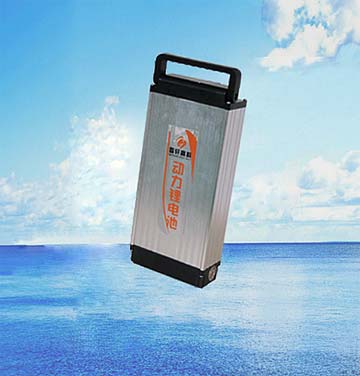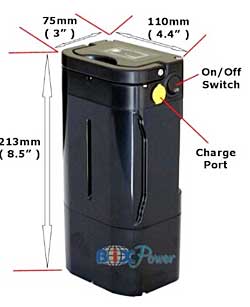Electric Bike Batteries
When choosing electric bike batteries, keep in mind that
these affect your bike's weight. As a consequence, your driving
distance becomes affected. The battery recharging time and
its lifespan also affects your e-bike performance.
|
|
 Electric Bike Battery
Electric Bike Battery |
Currently increasing in popularity as a healthy and a green
method of easy transportation, electric bikes are slowly coming
into the spotlight as a great, eco-friendly way of getting
around. These bikes offer cycling which is power-assisted,
with a rechargeable battery powering its motor.
Cyclists still need to pedal, especially when the road you
are on has hilly areas, since relying solely on the battery
tends to drain it quickly. Riders who use their electric bikes
for short distances can opt not to pedal at all, and let the
bike's motor do all the work.
The different types of electric bike batteries include SLA's,
NiMH, Li-ion and Li-Po. SLA's are Sealed Lead Acid, which
are very affordable in terms of production and are commonly
used by electric bike owners. These need very little maintenance
and contain a high density of energy. Typically thirty pounds,
these cannot be quickly charged and tend to die out when the
cells of the battery become old.
NiMH batteries are Nickel-Metal Hydride. These give you the
advantage of charging quickly and are both less toxic and
are lighter than Sealed Lead Acid batteries. High density
energy is maintained by these batteries, giving you both speed
and power. The down side of this battery is that cold weather
conditions tend to reduce the battery life and in order to
maximize the battery's life, frequent discharges at specific
intervals need to be planned.
 |
Li-ion Roars!
Li-ion batteries are another name for Lithium-Ion
batteries. These types of batteries are maintenance
free and lightweight at the same time. Not only do
these charge rapidly, the longer life these batteries
have make their higher price worth it.
|
Keep in mind that the chemicals need to be stabilized, and
you will need a system for battery management when using these
types of batteries for your electric bike. Within each lithium
cell, the temperature and the charges also need to be monitored.
The most current types of Li-ion batteries use iron phosphates,
making them much more stable than their previous counterparts.
Li-Po batteries are Lithium-Polymer cells and are the lightest
e-bike batteries. The most current of all the batteries, these
weigh just ten pounds and are extremely stable. You can find
electric bike batteries for between $150 for an SLA to more
than $500 for the most current Lithium iron phosphate battery
selections.
In Conclusion ...
The two factors to consider when choosing an electric battery
are the weight and the price. You also need to take the longevity,
rechargeable time and performance of each battery before you
decide to buy it. Read all the small print if you can, since
many times, manufacturers create lighter batteries that have
less battery life. If you plan to use your electric bike daily
on the same route, you need a fast-recharging Lithium battery
and a spare. If you very rarely bike, you might be happy with
an SLA battery, and get a great workout in the process.
|


